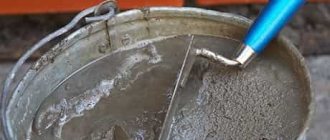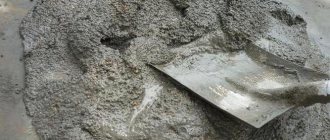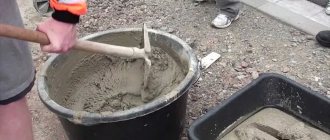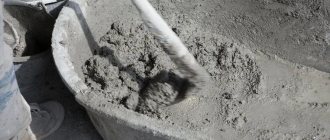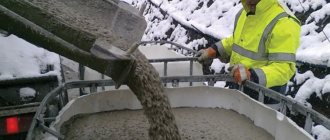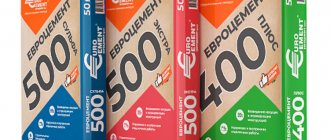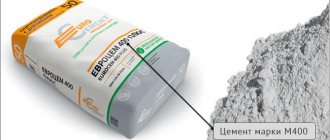Home |Types of concrete |Characteristics of concrete M150
Date: November 20, 2017
Comments: 0
Not a single construction operation associated with the construction of industrial and private facilities can be completed without the use of concrete solutions. The strength characteristics, cost, and scope of application of concrete directly depend on the amount of the main component - cement in a certain volume of the composition. Concrete M150 is one of the composites that has sufficient strength characteristics that allow it to be used to solve various construction problems.
Concrete M150 - characteristics
The concrete solution has a corresponding alphanumeric designation, in which the digital index characterizes the strength.
Let's consider the main characteristics of the composite, which include:
- strength (131–164 kgf/cm²). The tensile strength is determined experimentally in laboratory conditions. Strength increases throughout the entire period of concrete settling and stops changing only after complete drying;
- density. The density indicator varies depending on the filler used. The density of sand, crushed stone, gravel differs significantly, which is accordingly reflected in the performance of the concrete solution;
- mobility (P1–P4). This parameter depends on the amount of water used during mixing;
- class and brand (B12.5; M150). These are the main indicators characterizing the strength characteristics of concrete under compression;
- waterproof (W2). The water resistance index characterizes the ability of a material to absorb moisture. If water absorption is high, it is recommended to additionally use waterproofing materials;
Concrete is an indispensable building material. No construction can be completed without it.
- frost resistance (F50). The number corresponds to the number of freezing cycles that the material can withstand without destruction. F50 is a low indicator that significantly limits the scope of application;
- setting speed. For this composition, this characteristic is quite important, since M 150 concrete is quick-hardening. This allows it to be used during construction activities that are limited in time.
The performance characteristics of concrete M150 class 12.5 depend on the formulation used, as well as the quality of the components included in the mixture.
Mounting solution M-150 according to GOST and SNiP
Mounting mortar M150 (GOST 28013-98) is a standard construction cement containing a mixture prepared from Portland cement, sand and water. According to GOST, the mixture must be produced centrally at mortar units or reinforced concrete factories. Delivery of the mortar to the construction site must be carried out within the allotted time, using mortar trucks or specially equipped dump trucks.
The water used for mixing the mortar mixture must undergo laboratory testing to detect harmful impurities, as well as substances that interfere with the natural hardening and strength gain of the mortar.
The solution that has separated during transportation must be thoroughly mixed before starting work. The use of a mixture that has set and has lost its mobility is not permissible. It is also not permissible to restore the mixture by introducing additional amounts of water and Portland cement.
A high-quality mounting mortar M150 at the age of 28 days should show an average strength value equal to 100%.
The mortar mixture may include various additives - pigments, dyes, binders. Most additives are added to the mortar mixture in order to increase the adhesion strength of the mortar mixture during extreme construction work.
Pigment additives can be used to adjust and change the color of the solution. Colored masonry mixtures provide personalization and can enhance the appeal of brick or concrete masonry.
Composition of concrete M150
The ingredients that make up any concrete composition are the same. Concrete differs depending on the percentage of each component.
The M150 brand mixture is made from available ingredients:
- cement. For preparation, cement M400 or M500 is used;
- crushed stone The most commonly used crushed stone is limestone or gravel, with particle sizes ranging from 5–20 mm. The use of a larger fraction is unprofitable;
- fine filler - sand. Material class - second. The use of a material of a higher class is impractical, since it will lead to an increase in cost without changing the strength characteristics;
- technical water. The percentage of water in the M150 solution is quite high compared to other, higher grades. The increased water content ensures good mobility of the composition. This allows you to carry out plastering work on the walls and ceilings of buildings under construction without any problems.
Quality control of the materials used in industrial production is carried out in laboratories.
Concrete grade M150 is widely used when pouring reinforced concrete products
Features of using sand-cement mixture M150
M150 is the most common solution that is used for:
- sealing seams and joints;
- preparing surfaces for gluing or painting;
- pouring foundations;
- making floor screeds;
- plastering walls.
Cement-sand mortar M150 includes cement, sand and water. It hardens within 3-4 hours.
Portland cement, obtained from limestone stone, is used as the main binder. Used at ambient temperatures +5…+30˚С. The solution is applied to a surface cleaned of dirt and foreign objects.
Option for masonry cement grade 150.
Preparation is carried out as follows:
- the dry mixture is poured into a container and mixed;
- water is added and mixing continues.
The dry mixture can also be poured into water poured into a container for preparing the solution, and then diluted with water.
To obtain a homogeneous solution, it is recommended to mix it with a mixer, which is inserted into an electric drill. Due to rapid hardening, the mixture is prepared in small portions.
Concrete grade 150 - proportions
The production of the composition of the M150 brand can be carried out both in industrial and at home conditions. The main thing is to ensure uniform mixing of all ingredients, as well as maintain the necessary proportions to obtain a composition with the required parameters. The percentage of components is calculated taking into account various factors - particle size of crushed stone and sand, density, brand of cement used.
When making concrete mortar marked M 150, the following recommendations should be followed:
- Portland cement grade M400 must be mixed with crushed stone and sand in a mass ratio of 1:5.7:3.5. For volumetric dosing, mix 32 liters of sand with 50 liters of crushed stone and add 10 liters of cement. The result will be 62 liters of concrete mixture;
- Using cement marked M500, you need to take 6.6 kg of crushed stone per 1 kg of cement and mix the ingredients with 4.5 kg of sand. The volumetric proportion involves mixing 10 liters of cement with 40 liters of sand and 58 liters of crushed stone. This allows you to get 73 liters of solution.
The decision to use the volumetric method of measurement or weighing the components for preparing a concrete mixture is made individually. Both methods provide the required performance characteristics of the monolith, provided that high-quality components are used.
Due to its low price and good properties, it has gained popularity among other brands of concrete mortars
Advantages and disadvantages
Low strength limits the use of concrete mixture, but it has advantages:
- low price reduces overall construction costs;
- the availability of components allows you to make your own solution;
- the reliability of hardened concrete does not change with minor temperature fluctuations or deviations in humidity;
- long service life, provided the technology is followed;
- environmental safety thanks to the use of non-toxic components.
A significant disadvantage of liquid concrete grade M150 is the effect of low temperatures on the strength characteristics, which jeopardizes the integrity and stability of the building. This is the main reason why BST M150 is not used as the main liquid building material.
Low strength does not prevent it from being a monolithic material in demand in the construction industry. It is important to maintain proportions during manufacture, use only in places that do not involve heavy loads, and then the mass will last a long time. When purchasing a solution, be sure to pay attention to the accompanying documentation.
Advantages of brand 150
Despite the insufficiently high strength characteristics and certain restrictions on the scope of use, a solution marked M150 has certain advantages:
- reasonable price. Due to the low cost of purchasing this building material, the total cost of construction activities is reduced;
- reliability. Under the influence of temperature fluctuations and humidity deviations, the concrete mass does not collapse;
- long service life. If the manufacturing technology is followed, the monolith retains its properties for a long period;
- environmental cleanliness. Environmentally friendly ingredients are used to make concrete mortar.
By deciding to use M150 concrete mortar to perform certain construction tasks, you can save money. After all, the mixture is easy to make on your own at a construction site.
Technical characteristics and advantages of the mixture
Cement mortar M150 is an environmentally friendly substance.
It is resistant to open flames and has the following characteristics:
- tensile strength - more than 3 MPa;
- for compression - 15 MPa or more;
- beginning of hardening - 40-60 minutes after installation;
- complete hardening - after 1 month.
The characteristics of the mixture can be changed by adding various chemicals to it.
At the same time, the plasticity and homogeneity of the solution are preserved.
The advantages of the mixture include:
- the ability to obtain an even layer without chips and cracks;
- high strength of the dried layer;
- uniform density;
- high frost resistance.
Areas of use
Concrete M 150, the characteristics of which are not particularly high, has some limitations in terms of application. It is undesirable to use this composite under sudden temperature fluctuations and high humidity.
Due to the low level of resistance to environmental influences, it is rarely used in the construction of facilities that can withstand heavy loads.
Concrete mortar grade 150 is used for the following work:
- pouring foundations for non-critical purposes. Private developers quite often use inexpensive grades of concrete when arranging foundations for light buildings - sheds, gazebos, open sheds for storing cars;
- preparing the base for laying the foundation of the building. Any construction project needs a high-quality foundation that is responsible for the durability of the structure. Therefore, after carrying out soil compaction measures, M150 concrete mortar is poured, forming an intermediate strength layer between the soil and the foundation;
- arrangement of sites for the installation of small structures. The installation of temporary kiosks, stalls, and various retail outlets does not require the creation of durable, expensive foundations;
- creating a “cushion” under the main road surface. As part of the struggle to save money when laying road surfaces, M150 concrete mortar is simply irreplaceable. It is easy to install, has a low cost, and is strong enough to create an underlay for the main surface on roads with light traffic;
- pouring screeds under some types of floor coverings. Carrying out a screed with this composition also implies the creation of an intermediate layer capable of taking on a certain part of the expected loads;
- preparing and leveling walls for further finishing. Use is possible if no coarse filler was involved in the preparation;
- concreting posts for fences, borders, garden paths. M150 solution is not used in its pure form for pouring concrete paths, as it is susceptible to natural factors. It is widely used as a binding component when laying natural or artificial stone, decorative slabs, and borders.
The range of applications for M150 concrete is quite diverse due to its favorable price-quality ratio.
Conclusion
Concrete M150 is a lightweight, not heavy concrete solution. The correct proportion and type of coarse aggregate influence the future mixture. They determine what characteristics the solution will have: strength and density. Additives affect the level of water resistance and frost resistance.
This type of concrete is used for preparatory construction work. Due to its technical properties, it is not able to withstand heavy loads, so it is used for plastering, pouring floors, paths, etc. The concrete solution hardens quickly, which allows construction work to continue after a short period of time.
